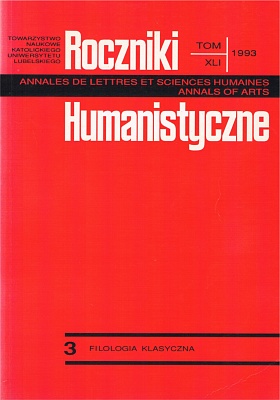The Motif of the Prodigal Son in the Latin Religious Drama of the Renaissance. On the Basis of the Netherlandic Drama
Abstract
The author discusses two dramatic works of Netherlandic authors: Asotus by Georgius Macropedius and Acolastus by Gulielmus Gnapheus. Both works belong to a large group of the paraphrases of biblical themes which were very numerous in the period of the Renaissance. In these works we deal with a particular kind of imitating the ancients (imitatio antiquorum) which was the capital creative principle of the Renaissance: the patterns are at the same time the Bible and classical poetry. The latter comes from the fact that both literary traditions, Christian and classical, are characterized by a love and, in a sense, cult of the word. The word in the Bible is based on a transcendent power as the word acting (creating, revealing, redeming, redempting) God. The classical tradition would emphasize the power of the human word which power comes from its form. It is not a power in itself (in opposition to the power of the divine word), but a power purchased by art. Having these two concepts of the word at their disposal the poets of the Renaissance made notice that the literary form of the Bible did not meet the criteria of the rhetoric beauty. This was one of the reasons why they sought somehow to „help” God’s word, giving it a beautiful form according to the rhetoric canons. It seems that the second factor which influenced the establishment of many paraphrases was the religious debates induced by the Reformation. Putting a new form on the well-known biblical themes one could freely choose proportions, skillfully distribute emotional stress, and thus prove this or that religious thesis. Comparing Macropedius’ (a Catholic) and Gnapheus’ (a Protestant) dramas one can notice both similarities and differences. The theme in both works is the same, i.e. the story of the prodigal son. They both patterned them on the same biblical problem parabole, and both reach to the Roman comedy as their subsequent pattern. Here one can, however, notice difference. Macropedius based himself to a large extent on Plautus’ comedy Mostellaria. Gnapheus made use of Terence’s play Andria as his pattern. He is also not so close to the Roman pattern as Macropedius. The latter, in turn, aside to the motif of the prodigal son makes use in his work of the motif of the good and bad servant. The social differences in treating the themes as seen in both authors result from their different religious beliefs. The Catholic Macropedius while making use of the parabole about the good and bad servant seeks to enhance the argument in favour of the thesis that it is man’s behaviour as a free human being that decides about his salvation. Gnapheus, however, in line with the teaching of Luther takes a different standpoint, namely, that life is governed by necessity, and man’s behaviour has no bearing on his salvation. In the foreword to his play the author makes a stipulation that it does not tell about religious rumours. One can notice here apperent allusions to the teaching of Luther. Both plays are an interesting example for the use of literature in religious propaganda and debate, which was very common phenomenon in the 16th century.
Copyright (c) 1993 Roczniki Humanistyczne

This work is licensed under a Creative Commons Attribution-NonCommercial-NoDerivatives 4.0 International License.





